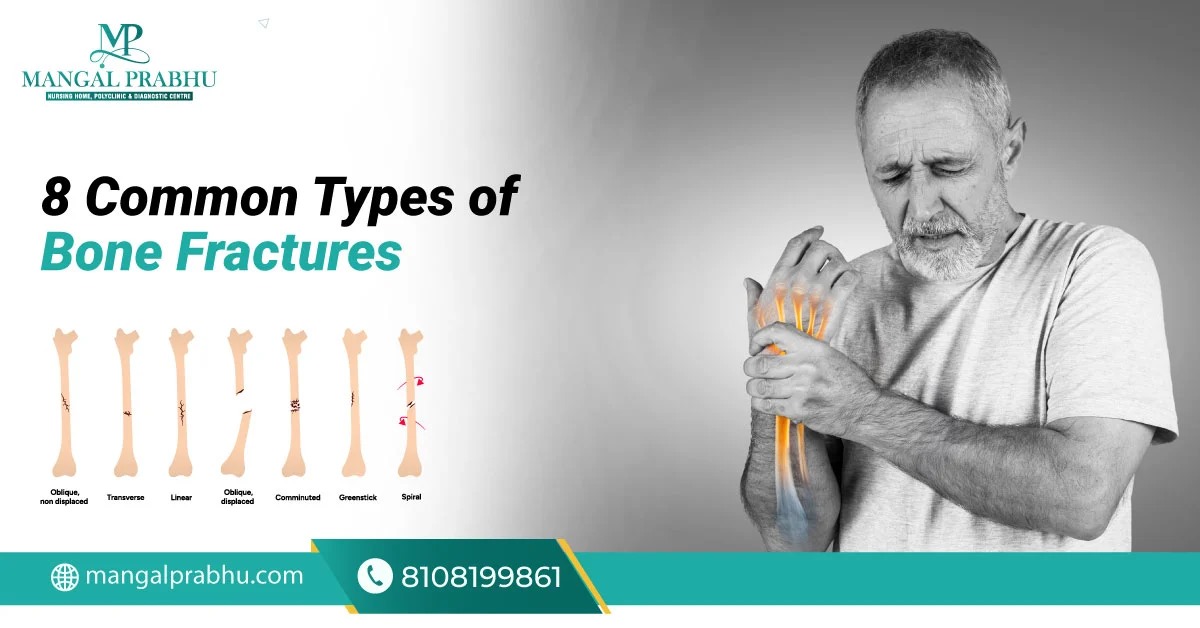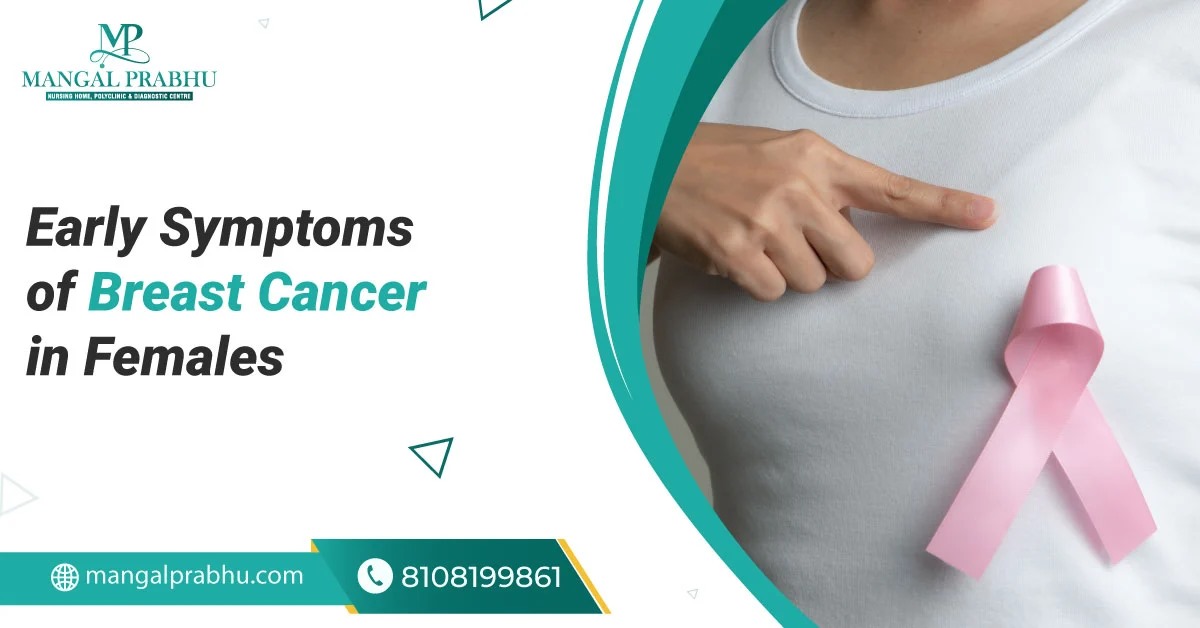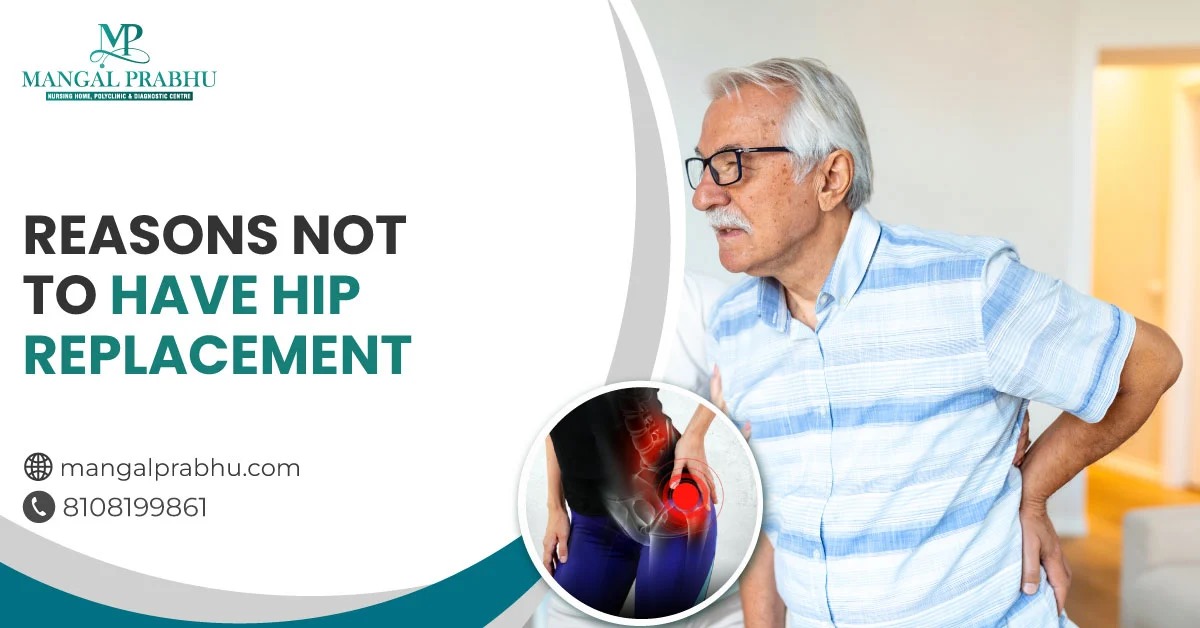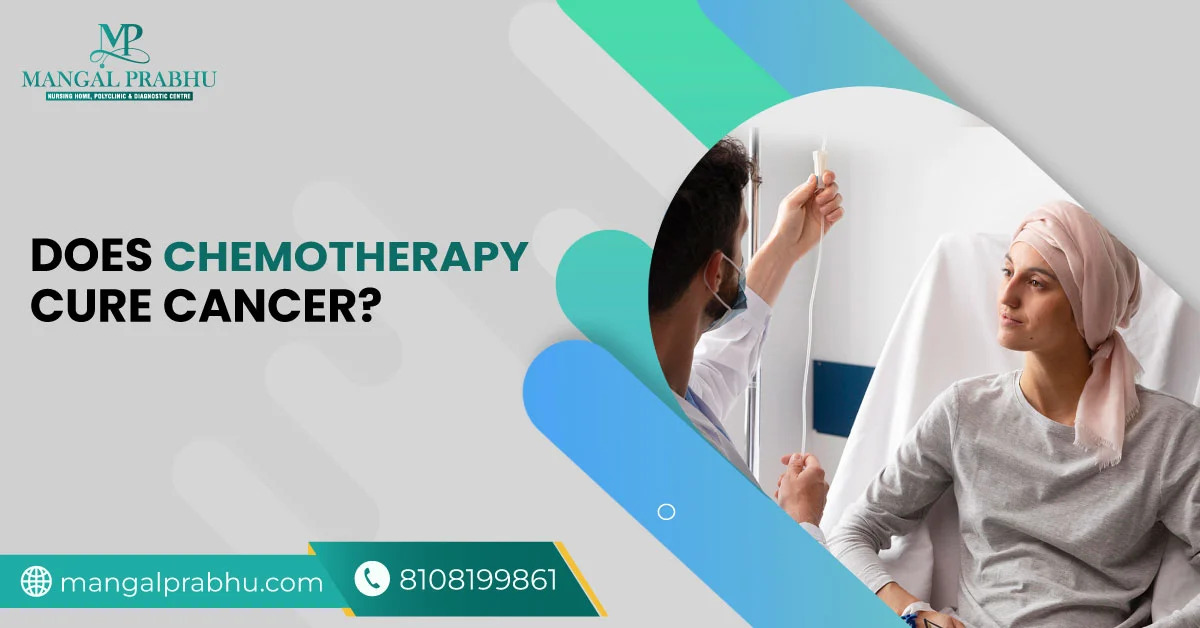
8 Types of Bone Fractures
Bone fracture refers to the broken or cracked bones. Although anyone at any age can experience a bone fracture, they are more common in older people (above 50 years). The risk is higher in people diagnosed with osteoporosis. Visit an orthopedic hospital in Navi Mumbai for bone density screening. The test detects weak and brittle bones and also suggests your likelihood of getting bone fractures. In the meantime, let’s explore the eight most common types of bone fractures.
8 Types of Bone Fractures
1) Simple Fracture
A simple fracture occurs when the bone breaks but does not cause any visible injury on the skin or break through your skin. There’s no severe tissue damage, as the bone is contained within your body. The bone might slightly displace or remain completely aligned with little damage to the soft tissue. Rest and immobilization are the most effective treatment options for simple fractures.
2) Compound Fractures
A compound fracture is more severe than a simple fracture. It occurs when the bone breaks and pierces your skin, leading to a severe wound. It’s caused by a fall from a great height or a car accident that puts excessive force on your bones, causing them to break and injure your skin. You will notice the bone sticking out of your skin and severe bleeding. See an orthopedic doctor in Navi Mumbai immediately if you notice these signs.
3) Comminuted Fractures
A car crash or other severe accident can result in your bone getting broken into many pieces. It’s another serious type of bone crack that requires hospitalization. The treatment for comminuted bone fractures is a surgical repair. The broken bones can take a year or longer to heal completely.
4) Greenstick Fractures
In greenstick fractures, your bone bends so much that it cracks slightly but does not break into multiple pieces. They result from sports injuries, falls, and other kinds of trauma. They are common in children, as children’s bones are weaker compared to adults.
5) Transverse Fractures
A transverse fracture is a bone crack that goes straight across the bone. It looks like a horizontal cut. The crack occurs from a fall or a heavy object hitting your bone. Immobilization is usually recommended for transverse fracture, but surgery might be needed if the bones’ alignment is affected.
6) Oblique Fractures
An oblique fracture is a diagonal crack, usually found in the long bones. These also occur from trauma to your bone due to a fall or an accident.
7) Spiral Fractures
Spiral fractures occur due to a sudden twisting motion, especially during strenuous physical activities or sports. These look like a corkscrew, a spiral line that goes all the way around the bone.
8) Compression Fractures
Compression fractures occur in the vertebra in your spine. They are most common in people with osteoporosis or a weakened spine, which is likely to collapse if you experience a fall, injury, or any accident that hits your spinal area.
Conclusion
Bone fractures are common and mostly occur because of trauma to your bones. These are more common in people with weaker bones (especially elders) than healthy ones. Treatment includes immobilization and surgery in severe cases.

10 Things a Pregnant Woman Needs
Ask any woman about their pregnancy journey, and you will likely hear different answers. Each woman has a unique pregnancy experience. Some experience severe nausea that lasts throughout the nine months, while others have a smooth pregnancy journey with no severe symptoms and fewer visits to pregnancy hospital in Navi Mumbai. To help you make the best of this time, we’ve listed the top ten pregnancy gears that every woman should include in her must-have-pregnancy-stuff list.
10 Things a Pregnant Woman Needs
1) Prenatal Vitamins
Start with folic acid. It’s mandatory for pregnant women and those planning conception. Folic acid reduces the risk of neural tube defects and congenital abnormalities in babies. Other prenatal vitamins you need during pregnancy include calcium, iron, vitamin D, Vitamin C, Vitamin B12, and more.
2) Comfortable Maternity Clothing
As your body grows, you need comfortable maternity clothing to adapt to changes, such as a growing belly and sudden weight gain. Pregnancy also brings joint pain and muscle aches. To feel comfortable, order some maternity clothes, preferably loose-stitched long gowns.
3) Hydration and Healthy Snacks
Your body’s demand for calories and vital nutrients increases during pregnancy. Increasing your calorie intake is important to support your growing baby’s requirements and keep yourself healthy. It’s equally important to drink plenty of water, around 8-12 cups a day, to stay hydrated.
4) Prenatal Care
Schedule regular appointments with your gynecologist as part of your prenatal care. They will monitor your vitals, such as blood pressure. The doctor will also order ultrasound and other tests to ensure the mother’s and the baby’s wellbeing.
5) Supportive Footwear
Pregnancy is not the best time to flaunt your brand-new spiky heels. Anything that puts you at risk of accidental falls should be avoided. You should get a couple of flats or comfortable shoes that offer proper foot support while preventing falls.
6) Rest and Relaxation
Your body needs rest during pregnancy. The physical exhaustion from increased blood volume and the growing fetus can put a lot of physical and mental stress on your body. To combat the stress, you should aim for sufficient rest. Sleep for at least 8-9 hours a day.
7) Pregnancy Pillow
Adding a pillow or two beneath your legs can help a lot. It makes your sleep a whole lot more comfortable. You can choose from c-shaped, wedged, U-shaped, and full-length pillows.
8) Exercise Routine
Many women feel intimidated by the idea of exercising during pregnancy. However, it’s important to create a proper exercise routine, practicing yoga, stretches, and basic exercises throughout the nine months. Speak with an obstetrician in Navi Mumbai to know whether starting exercises is safe.
9) Education and Resources
Getting the right book for your pregnancy and childbirth journey can help you learn a lot about what’s normal and what’s not. It also helps you prepare for labor, delivery, and post-partum care.
10) Emotional Support
Pregnancy hormones bring a significant change in your physical and mental health. It’s normal to feel stressed, mentally exhausted, and depressed at times. Spend quality time with your loved ones and practice meditation to improve your mental wellbeing. Seek professional care if your pregnancy blues get out of control.

Signs of Bladder Stones in Females
A combination of minerals can crystallize and form a mass in your bladder, leading to bladder stones. Some of these are small and often pass on their own through urine. Others, however, might require a surgical removal. Although it’s more common in older males, anyone, including women, can develop bladder stones.
The common signs are abdominal pain and difficulty urinating. We’ve researched the most common and less obvious yet possible warning signs of bladder stones. Let’s check out the symptoms and when to seek help from a urologist in Navi Mumbai.
Common Signs of Bladder Stones in Females
a) Painful Urination:
The most obvious sign of bladder stones in females is pain while urinating. This happens when the stone obstructs the flow of urine or irritates the bladder lining, making urination painful. The pain is exacerbated if the stones lead to an infection or inflammation in the bladder.
b) Frequent Urge to Urinate:
Stones block the urine flow, making it difficult to empty the bladder fully. This can lead to frequent urination or the urge to urinate more often than usual. The stone can also put pressure on the bladder, causing frequent urination.
c) Hematuria:
Hematuria, or blood in the urine, occurs when the stones in your bladder irritate the bladder lining, which might result in visible blood in your pee. This happens when the stones sit around for a prolonged period or grow in size.
d) Dark Urine:
Less fluid intake or the presence of blood in the urine can make it appear darker. Certain types of stone composition can also change the urine color.
Less Common Signs of Bladder Stones in Females
There are a few less obvious signs that indicate bladder stones. Although they don’t occur in every patient, it’s important to watch out for these symptoms and report them to your urologist.
A) Lower Abdominal Pain:
Bladder stones can cause abdominal pain, which can be mild or severe, depending on the size of the stone. In women, particularly, the pain might radiate to the pelvic floor muscles and the back.
B) Painful Intercourse:
In females, bladder stones can put pressure on the pelvic organs, leading to painful sexual intercourse.
C) Recurrent Urinary Tract Infections:
Bladder stones can lead to stagnant urine, in which the urine doesn’t leave your system because of the obstruction in its flow. This creates a perfect environment for bacteria to thrive, increasing your risk of catching urinary tract infections frequently.
D) Nausea and Vomiting:
If the stones have blocked a significant part of the bladder responsible for regulating urine flow, the patient might experience nausea and vomiting. That’s more common in women with UTI.
When to Seek Medical Help
Visit a urology hospital in Navi Mumbai if you experience persistent pain that gets intense in your lower abdomen. Prompt medical attention is necessary if the pain is accompanied by other bladder stone symptoms, including hematuria, difficulty peeing, high-grade fever, chills, and vomiting.
Bladder stones can grow if they remain undetected and untreated for a long time. Depending on the size and location of the stone, the urologist will either prescribe medication to pass it through urine or remove it surgically.

Early Symptoms of Breast Cancer in Females
Breast cancer occurs when the cells in your breasts start growing abnormally. It’s one of the most common types of cancer in women all over the world. Although it mainly occurs in women, a report by the World Health Organization (WHO) shows that 0.5 to 1 percent of breast cancers affect the male population.
Like any type of cancer, breast cancer can spread to the surrounding tissues and organs, and even lymph nodes when it reaches an advanced stage. Early detection followed by breast cancer treatment in Navi Mumbai can increase your survival rates.
Early Symptoms of Breast Cancer in Females
The survival rates in women diagnosed with breast cancer have been improving. That’s primarily because people are now more aware of the symptoms, and they get prompt medical care, which improves the treatment outcome.
As mentioned above, early detection is key to getting the best treatment. Here are the initial signs of breast cancer you must watch out for:
1) Breast Lumps
The first and most common sign of breast cancer is a visible lump that may have rounded or uneven edges. You must practice self-examination to spot any lumps on your breasts. Women above 40 and those with a family history of breast cancer should get mammograms every year, even if there’s no lump or pain.
2) Changes in Breast Size and Shape
If one or both of your breasts appear considerably larger or smaller than before, that’s a sign you should see a healthcare specialist immediately. Breast cancer can cause asymmetrical breasts. Changes in the nipples and their symmetry can also be the early sign of breast cancer.
3) Skin Changes
Several noticeable skin changes on your breasts can also indicate breast cancer. The most common changes include a visible dimple-like spot on the skin, puckering and scaling, and a red rash. Some women report swelling on their breasts and near the armpits before it turns into a visible lump.
Less Common Symptoms
When the cancer reaches an aggressive stage, you might experience advanced symptoms, like a clear discharge from one or both nipples. It can be whitish, yellow, green, or bloody. Any kind of discharge from your nipples, which isn’t milk, should be reported to the doctor.
i) Inverted Nipple
If you were born with inverted nipples, that’s usually not a cause for concern. However, if you notice a sudden inversion, especially in one of the nipples, it can be a sign of breast cancer. Nipple inversion can also indicate a benign condition, though. It’s best to get evaluated.
ii) Breast Pain
Breast pain can occur from many benign conditions. Hormonal changes, puberty, onset of menstruation, menopause, and breastfeeding are a few common causes of breast pain in women. However, if it’s persistent and accompanied by other symptoms mentioned above, see a gynecologist for a thorough evaluation.
When to See a Doctor
A visible lump on your breasts with nipple discharge, pain, and swelling might indicate breast cancer. You must schedule an appointment with an oncologist in Navi Mumbai to know whether it’s a benign condition or cancer. They will order a mammogram—a breast X-ray that detects cancer and its stage.

Is Chemo Only for Cancer?
What’s the first word that comes to your mind when you hear the word chemotherapy? Cancer. Chemotherapy is the most common treatment for different types and stages of cancer. Depending on the severity of the cancer, oncologists in Navi Mumbai perform chemotherapy either as a standalone treatment or in conjunction with surgery, radiation therapy, hormone therapy, and other procedures.
The question is, is chemotherapy only for cancer? No! It’s also used to treat certain autoimmune disorders and blood disorders. Let’s see what chemotherapy can treat.
Common Uses of Chemotherapy
For Cancer
More than a hundred types of chemotherapy drugs are used to treat different types of cancer. Cancer cells are known for multiplying rapidly. The initial stage of cancer is often confined to a specific organ, but it can spread to the surrounding tissues, lymph nodes, and organs if left untreated. Treatment gets harder as the cancer reaches an advanced stage.
Chemotherapy drugs kill the rapidly multiplying cancer cells. The goal of the treatment is to stop the cancer cells from growing or replicating. The number of chemotherapies required for each patient can vary depending on their cancer diagnosis and how far it’s spread.
For Non-Cancerous Diseases
Chemotherapy can be used in low doses or high doses for non-cancerous conditions, especially autoimmune disorders.
i) Autoimmune Disorders:
Lupus and other autoimmune disorders, in which your immune system attacks your organs and tissues, can be treated with chemotherapy. The therapy can suppress an overactive immune system.
ii) Bone Marrow Disorders:
Bone marrow diseases in which your bone marrow fails to produce adequate red blood cells might require chemotherapy combined with blood transfusion and bone marrow transplant. Chemotherapy is often performed before a bone marrow transplant to destroy the damaged bone marrow cells.
iii) Infections:
Some types of severe and persistent fungal infections can be treated with chemotherapy. Antifungal agents are used to offer relief to the patient. Viral infections that do not respond to the antiviral medication might also require chemotherapy, especially in patients with compromised immune systems.
Potential Side Effects of Chemotherapy
As mentioned earlier, chemotherapy kills cells that grow rapidly, which might also include the healthy cells in your gut and those responsible for your hair growth. So, side effects are not uncommon after each session. The severity of the side effects and how long they last depends on the chemo drugs you are given and the dosage. Here are possible side-effects of chemotherapy:
- Fatigue
- Hair loss
- Mouth sores
- Memory loss (also called chemo brain)
- Fertility issues
- Nausea and vomiting
- Loss of appetite
- Diarrhea or constipation
The side effects can vary from person to person. These are short-term issues that resolve on their own once the treatment stops and the new cells start to grow. Chemotherapy is also associated with long-term side effects, such as damage to your vital organs, like the heart, lungs, and reproductive system.
Conclusion
You can learn more about different types of chemotherapies and multiple methods used to administer the chemotherapy drugs into your body at the chemotherapy hospital in Navi Mumbai.

Reasons Not to Have Hip Replacement
Do you have constant hip pain that won’t resolve with over-the-counter medication, therapy, or non-invasive medical procedures? Are you diagnosed with arthritis? People with worn-out hip joints might experience severe pain in their hips, which worsens when you move, lift objects, or practice strenuous physical exercise that involves your hip joint.
A hip replacement surgeon in Navi Mumbai will most likely recommend a surgical removal of the damaged joint and its replacement with an artificial implant made of plastic, ceramic, or metal. But is it the right choice? Let’s find out.
Potential Risks and Complications
Hip replacement has many benefits. It helps you regain your mobility. Total hip replacement strengthens your hip joint and makes movements easier and painless. But like any invasive procedure, hip replacement doesn’t come without risks.
It’s important to weigh the risks and benefits before proceeding with hip replacement. Let’s explore the common risks and complications of the surgery.
1) Infection:
Although your surgeon will use sterile equipment and prescribe antibiotics, there’s still a possibility of infection post-surgery. If the infection goes deep near the prosthesis, another surgery might be required to replace the infected portion with a new implant.
2) Blood Clot:
Lack of movement after surgery can put you at risk of Pulmonary Embolism (PE) — a medical condition in which the blood clot travels to your lungs, blocking the blood flow. You must start a movement within 24-48 hours after surgery. Your healthcare provider will recommend blood thinners to prevent blood clots.
3) Dislocation of Implants:
The tissues around the incision site take time to heal. During this time, they might not be strong enough to provide support to the artificial implants. If you move too much, bend a lot, or practice stretching and other movements, there’s a risk of joint dislocation. A surgery is required to re-position your artificial hip joints.
4) Nerve Damage:
Nerve damage is a rare but possible complication of hip replacement surgery. Damage to the surrounding nerves can make the affected site numb, weak, and painful.
Alternative Treatment Options
If you are not a good candidate for hip replacement or are simply looking for alternative treatment options, a few non-invasive procedures can help improve your mobility. Here’s what may help.
- Weight loss plans to prevent excess strain on your hip joint
- Physical exercise, like walking and swimming, to strengthen your hip joint, regain your mobility, and maintain flexibility
- Use canes, crutches, and other walking aids to offer relief to the damaged hip
- Pain relief and anti-inflammatory medication
- Acupuncture and massage therapy for pain relief
Long-Term Considerations
Mild stiffness and pain around the incision site are pretty common. They resolve on their own within a few weeks following surgery. Remember, the implants used to replace the damaged joints can wear in 5-10 years or sooner, depending on the material used and your movements. Some patients develop an allergic reaction to the implant material, requiring a revision surgery.
Hip replacement surgery in Navi Mumbai is beneficial for patients with extreme pain and loss of mobility, but you should always opt for noninvasive procedures first.

Understanding White Discharge in Early Pregnancy
White vaginal discharge is not uncommon in women. However, an increased volume of discharge or a change in its color and texture can indicate an issue. Sometimes, an increased amount of white discharge can indicate pregnancy.
If you notice a drastic change in your vaginal discharge and it looks unusual, it’s best to visit a pregnancy hospital in Navi Mumbai to rule out the possibility of an infection or other health issues. Let’s learn more about the causes of white discharge, what it looks like, and how to manage it.
Causes of White Discharge in Early Pregnancy
Pregnancy-related vaginal discharge is called leukorrhea—a thin, white vaginal discharge that’s often seen in your early pregnancy.
During pregnancy, your primary reproductive hormones—estrogen and progesterone—increase rapidly. This leads to increased blood circulation to your pelvic floor, causing an increase in vaginal discharge.
Your pregnancy hormones result in the formation of mucus plug in your cervix, which creates a barrier protecting your uterus from infection. The cervical mucus can also cause excess white discharge. The cervical mucus leaks upon reaching full-term pregnancy.
Characteristics of White Discharge in Early Pregnancy
White discharge during pregnancy looks similar to the vaginal discharge you experience regularly. It can be thin, clear, or milky-white. What’s not common is a change in the texture of this discharge in early pregnancy. If the discharge becomes thicker or it keeps leaking continuously, it might indicate an underlying issue.
Pregnant women can experience white discharge throughout their pregnancy, and that’s completely normal as long as it’s not thick, has a jelly-like texture, or has lumps. Abnormal vaginal discharge also has a strong, unusual, fishy odor.
Vaginal bleeding during early pregnancy or at any stage during pregnancy is never normal. Sometimes, pink, brownish, or red discharge in early pregnancy indicates implantation bleeding. It can also occur later in your pregnancy, especially after a pelvic exam or sexual intercourse. Note that any kind of bleeding should be reported to a gynecologist and obstetrician in Navi Mumbai.
Managing White Discharge in Early Pregnancy
Normal white vaginal discharge in early pregnancy is absolutely normal and can be managed at home. These tips will help:
- Do not use scented products, soaps, or vaginal creams unless prescribed by your gynecologist
- Keep your vagina clean and dry to prevent infection
- You can wear pads to soak white discharge. Avoid tampons.
- Avoid douching during pregnancy.
- Avoid using wet wipes. Your genital area has self-cleansing properties. Using chemical-based wipes can irritate your genital tract and can affect your pH level.
- Always clean your vagina front to back after emptying the bowels.
- Do not wear tight panties or jeans. Avoid nylon and polyester fabrics.
- Drink enough fluids to stay hydrated and eat a balanced and healthy diet.
Conclusion
White vaginal discharge or leukorrhea occurs during early pregnancy, and it might continue throughout pregnancy. If you notice any unusual discharge, change in color, or the amount, seek medical advice. Sometimes, vaginal discharge, especially if it’s green or yellow, indicates an infection.

Does Chemotherapy Cure Cancer?
Recovery from cancer is not a cakewalk. The first thing that strikes our mind when it comes to cancer is chemotherapy. It’s a treatment used to kill cancer cells through intravenous administration of the drugs.
These drugs are designed to destroy the rapidly multiplying cells, thus inhibiting cancer growth. While chemotherapy treatment in Navi Mumbai is quite effective in treating cancer, the procedure comes with many side effects. Besides, there’s no guarantee it will cure cancer and prevent relapse.
How Chemotherapy Works
Depending on the type and stage of cancer, chemotherapy can be used as a standalone procedure or in conjunction with radiation therapy and surgery. It can shrink the tumor and destroy cancer cells. Most chemotherapy drugs are given intravenously, but your doctor might recommend a topical application, a single injection shot, or pills.
An oncologist in Navi Mumbai will tell you the number of chemotherapy sessions you need to undergo to kill cancer. Then, based on how your body responds to the treatment, your doctor will either stick to the plan or advise additional treatment, such as surgical removal of the tumor, radiation therapy, or hormone therapy, for the best outcome.
Effectiveness of Chemotherapy
The effectiveness of chemotherapy can vary for each patient. It depends on the type of cancer, the patient’s overall health, the size of the tumor, and how far it’s spread. However, studies show that those exposed to chemotherapy have a better survival rate than those who never undergo chemo. The sooner you report your symptoms and get an accurate diagnosis, the higher your survival rates.
Note that cancer can return even after you are declared cancer-free. Some types of cancer have a chance of relapse, requiring more rounds of chemotherapy. Your oncologist will schedule regular follow-up visits to ensure the cancer has not returned.
Limitations of Chemotherapy
The chemo session isn’t always painful, especially not for those taking it through pills and topical. Intravenous chemo and injections can hurt a little, but it’s nothing more than a slight burning sensation.
Chemotherapy is used to destroy the rapidly growing cells in your body. That’s how it helps kill cancer fast. However, cancer cells are not the only cells that multiply quickly. The cells in your skin, hair follicles, digestive tracts, and other parts of the body also grow fast.
Cancer treatment can also destroy these healthy cells, leading to side effects such as hair loss, fatigue, constipation, diarrhea, vomiting, loss of appetite, and infection. The good news is that the side effects of chemotherapy last for a short while, usually until your treatment stops. Some side effects are, however, permanent. They include infertility, heart problems, and early menopause.
Conclusion
Chemotherapy is an effective way to kill cancer, but the treatment comes with side effects and is usually advised with surgery and other procedures. Ask your oncologist about the success rate of chemotherapy and the side effects. Fortunately, some types of cancer disappear completely following the chemotherapy and don’t require additional treatment. But there’s always a chance of a relapse.

What Not To Do After Knee Replacement?
People diagnosed with osteoarthritis and a completely torn ACL can get relief from knee replacement surgery. While non-invasive procedures, like physical therapy, can be helpful, it doesn’t work for everyone. Knee replacement has become fairly common.
A knee replacement surgeon in Navi Mumbai will provide detailed instructions for a speedy recovery after the procedure. There are certain do’s and don’ts you should follow to stay active and healthy. Here’s what to avoid after the surgery.
1) Ignoring Pain and Discomfort
Mild soreness and pain around the incision site might be normal, but severe pain or discomfort can be a warning sign. Talk to your surgeon if you experience pain while moving the affected joint, walking, or exercising. They will prescribe stronger pain-relief medication. Ice massage to the affected area can reduce swelling and help manage pain.
2) Skipping Physical Therapy
Physical therapy starts immediately after the surgery. Your surgeon will tell you which exercises are safe. It’s normal to experience discomfort during physical therapy, but that’s the best way to heal quickly. Attending physical therapy sessions will improve your mobility and increase your knee joint’s flexibility. It will also strengthen the muscles around your knee. Moreover, regular exercise improves blood flow throughout your body, thus preventing blood clots and other surgical complications.
3) Overexertion
Practicing light activities is okay, but do not overdo it. You should take a break from work for at least 6-8 weeks, and longer if you are an athlete or have a job that requires lots of movement. Ask your friends and family to help you with your household chores.
Remember, your priority should be healing. You can get back to work once your doctor gives the go-ahead. Starting work too soon or exhausting yourself can lead to pain after the surgery. So, focus on healing before resuming your routine.
4) Neglecting Wound Care
Infection and inflammation around the incision site can delay your recovery. Proper wound care is essential to keep the site clean. Not only does proper wound care reduce scarring, but it also prevents surgical complications, like excessive bleeding and reopened wounds. So, how exactly do you care for your wound after knee replacement surgery?
Keep the area clean and dry. Change the dressing regularly and watch out for the signs of infection. Follow a healthy diet and an active lifestyle. Over-the-counter pain relief medication can also help relieve pain.
5) Not Using Assistive Devices
Assistive devices, like crutches, cane, walking sticks, and other walking aids, are designed to provide comfort as you walk, stand, and climb stairs. These supportive devices are a must for patients who have undergone knee replacement surgery. The right supporting device will provide stability and support to your knee joint, making it easier to move around without pain. You can also get a ‘grabber’ to pick your stuff without bending.
Conclusion
Contact a specialist at an orthopedic hospital in Navi Mumbai and learn all about recovery after knee replacement surgery. Get the right walking aid and start physical therapy immediately to recover fast.

How to Take Care During Pregnancy of First Month?
Exciting news! You’re embarking on a journey of a pregnancy. As you start experiencing early signs like fatigue, nausea, vomiting, and sore breasts, it’s important to remember that the first trimester can be a rollercoaster. To ensure a smooth ride, consider visiting a pregnancy hospital in Navi Mumbai and consulting with the best gynecologist.
These tips will help you navigate the first trimester.
Healthy Lifestyle Choices
Watch your diet. Remember, your body needs only 300 extra calories in the initial stage of pregnancy, so you don’t have to eat for two. The food quality, however, plays a significant role in keeping you and the little one healthy. Add healthy snacks, protein, vitamins, and other nutrients to your diet.
Exercise is a great way to stay active and healthy. But don’t overdo it. Talk to your gynecologist before practicing any exercise, just to be on the safe side.
Prenatal Vitamins and Supplements
The first trimester of pregnancy lasts for 13 weeks. During this period, you are supposed to take prenatal vitamins to ensure proper fetal development. This includes 400 micrograms of folic acid daily. Your doctor will also recommend calcium, iron, and zinc supplements, which might last throughout your pregnancy.
Remember the Don’ts of the First Trimester
Alcohol, cigarettes, and tobacco should be totally avoided before and during pregnancy. You must also steer clear of excess coffee and other caffeine-rich foods, as well as unripe papaya and pineapple. Additionally, your gynec will advise you against eating the raw and undercooked meat. It increases your risk of contracting listeria and salmonella, which can cause miscarriage, premature birth, and severe birth defects in your baby.
Get Screenings
Prenatal care is important at every stage of pregnancy. Since the first few months are the most critical, you must consult a qualified gynecologist and obstetrician in Navi Mumbai every month or as frequently as they advise.
Your doctor will order blood work, urinalysis, and an ultrasound in the first month. These are done to evaluate your and the fetal health. The first-trimester ultrasound shows your baby’s heartbeat, estimated due date according to the fetal growth, and whether your pregnancy is progressing well.
Manage Pregnancy Symptoms
The first trimester is the hardest for most women. A surge in your estrogen combined with the pregnancy hormone Human Chorionic Gonadotropin can take a toll on your mental and physical health. Coping with the physical symptoms can be exhausting. These symptoms occur because of the development of the magical organ “placenta,” which is responsible for providing nourishment to the fetus. Hopefully, they will subside in the third or fourth month.
Your gynec will prescribe medication for nausea, vomiting, and other symptoms. Try to rest as much as possible. Surround yourself with positive people and stay hydrated.
Conclusion
It’s not just the physical symptoms that can be challenging, but the emotional changes due to the sudden rise in hormone levels are equally difficult. To stay healthy during pregnancy, stay active, eat a healthy diet, take your prenatal vitamins, and practice exercise and meditation.
